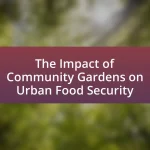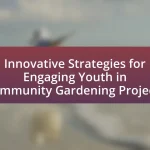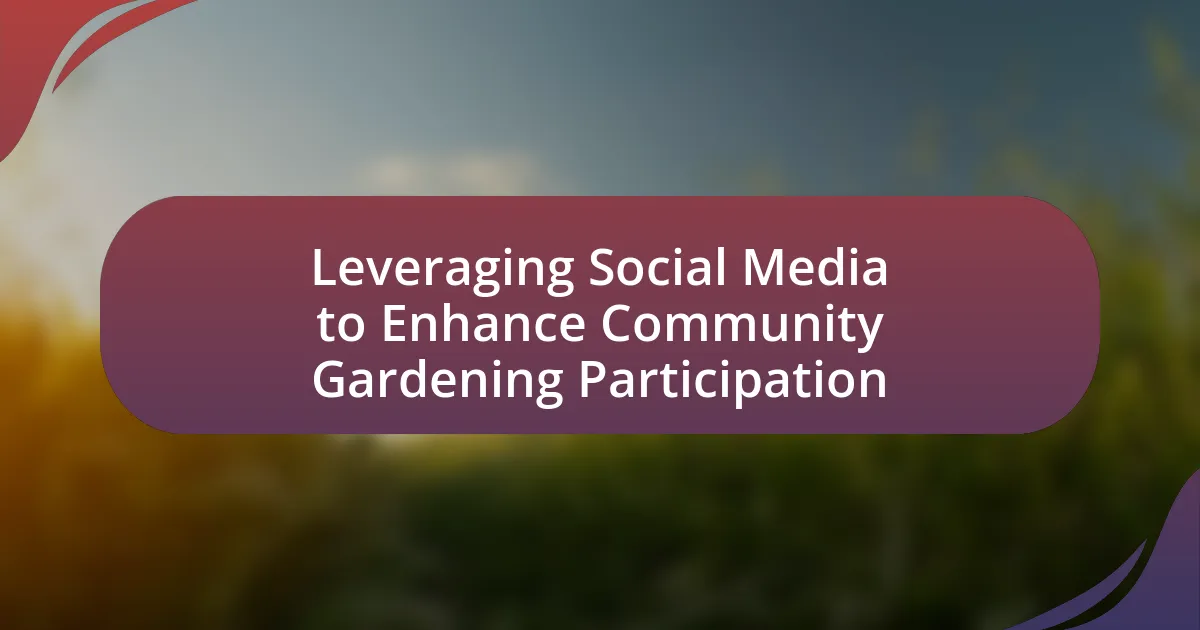Intergenerational gardening projects are initiatives that unite individuals from various age groups, particularly children and seniors, to engage in collaborative gardening activities. These projects enhance community engagement, promote knowledge sharing, and improve social connections, leading to benefits such as increased mental well-being and social cohesion. The article explores how these projects function within local communities, the distinct roles played by different age groups, the division of gardening tasks, and the overall impact on community building. Additionally, it addresses the health benefits associated with participation, challenges faced, and strategies for successful implementation, emphasizing the importance of inclusivity and effective support from community organizations.
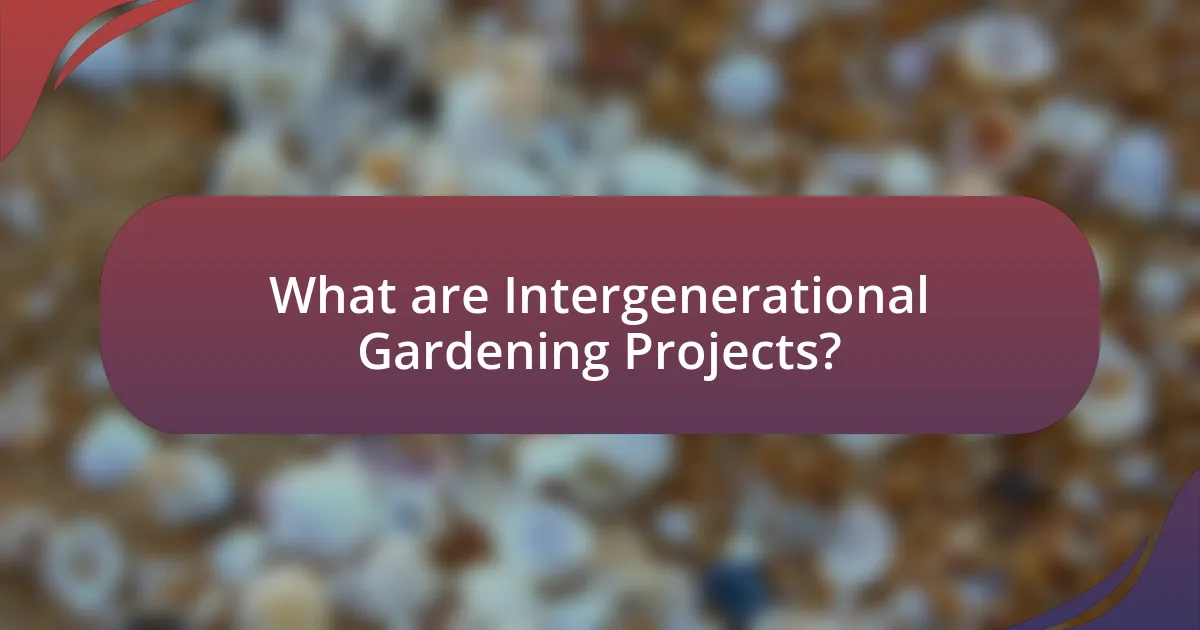
What are Intergenerational Gardening Projects?
Intergenerational gardening projects are initiatives that bring together individuals from different age groups, particularly children and seniors, to collaborate on gardening activities. These projects foster community engagement, promote knowledge sharing, and enhance social connections across generations. Research indicates that such projects can improve mental well-being and social cohesion, as they create opportunities for mentorship and learning, while also addressing food security and environmental sustainability.
How do Intergenerational Gardening Projects function in local communities?
Intergenerational gardening projects function in local communities by fostering collaboration between different age groups, primarily children and seniors, to cultivate gardens that serve educational, social, and environmental purposes. These projects create opportunities for knowledge exchange, where older participants share gardening skills and life experiences, while younger participants contribute energy and innovative ideas. Research indicates that such interactions enhance community cohesion, improve mental health for seniors, and promote healthy eating habits among children. For instance, a study published in the Journal of Community Health found that intergenerational gardening initiatives significantly increased participants’ social interactions and reduced feelings of isolation among elderly participants.
What roles do different age groups play in these projects?
In intergenerational gardening projects, different age groups play distinct yet complementary roles that enhance community engagement and learning. Younger participants, such as children and teenagers, often contribute energy, creativity, and a willingness to learn, which fosters innovation in gardening techniques and designs. They also benefit from mentorship provided by older adults, gaining knowledge about plant care and sustainability practices.
Older adults, on the other hand, bring experience, wisdom, and historical knowledge of gardening practices, which can guide younger participants in understanding the ecological and cultural significance of plants. Their involvement often includes teaching skills such as planting, harvesting, and preserving food, which are essential for fostering a sense of responsibility and connection to nature among younger generations.
Research indicates that these interactions not only improve gardening skills across age groups but also enhance social cohesion and reduce feelings of isolation, particularly among older adults. For instance, a study published in the Journal of Intergenerational Relationships highlights that intergenerational programs can significantly improve mental well-being and social networks for participants of all ages.
How are gardening tasks divided among participants of varying ages?
Gardening tasks are divided among participants of varying ages by assigning age-appropriate responsibilities that match their physical abilities and skills. For instance, younger participants often engage in tasks that require energy and enthusiasm, such as planting seeds, weeding, and harvesting, while older participants may take on roles that require more experience and knowledge, such as planning the garden layout, teaching techniques, or managing tools. This division not only enhances the efficiency of the gardening process but also fosters collaboration and learning across generations, as evidenced by studies showing that intergenerational gardening projects improve social bonds and knowledge transfer among participants.
Why are Intergenerational Gardening Projects important for community building?
Intergenerational gardening projects are important for community building because they foster connections between different age groups, enhancing social cohesion. These projects create opportunities for knowledge exchange, where older generations share gardening skills and life experiences with younger participants, promoting mutual respect and understanding. Research indicates that such interactions can reduce age-related stereotypes and improve community ties, as evidenced by a study published in the Journal of Community Psychology, which found that intergenerational programs significantly increased participants’ sense of belonging and community engagement.
How do these projects foster relationships between generations?
Intergenerational gardening projects foster relationships between generations by creating collaborative environments where individuals of different ages work together towards a common goal. These projects encourage knowledge sharing, as older participants impart gardening skills and life experiences to younger generations, while younger participants introduce new ideas and technologies. Research indicates that such interactions enhance social cohesion and mutual respect, leading to stronger community ties. For example, a study published in the Journal of Intergenerational Relationships found that participants in intergenerational gardening initiatives reported increased feelings of belonging and improved communication skills, demonstrating the positive impact of these projects on intergenerational relationships.
What impact do they have on community cohesion?
Intergenerational gardening projects significantly enhance community cohesion by fostering relationships across age groups. These projects create shared spaces where individuals of different generations collaborate, share knowledge, and build mutual respect. Research indicates that such initiatives can lead to increased social interaction and a sense of belonging among participants, which strengthens community ties. For instance, a study published in the Journal of Community Psychology found that intergenerational programs improve social networks and reduce isolation, thereby promoting a more cohesive community.

What are the key benefits of Intergenerational Gardening Projects?
Intergenerational gardening projects provide numerous benefits, including enhanced community cohesion, improved mental and physical health, and the transfer of knowledge between generations. These projects foster relationships among participants of different ages, promoting social interaction and reducing feelings of isolation, particularly among seniors. Research indicates that engaging in gardening activities can lead to lower stress levels and increased physical activity, contributing to better overall health. Additionally, these projects facilitate the sharing of gardening skills and cultural practices, enriching the community’s collective knowledge and fostering a sense of belonging.
How do these projects enhance social interaction?
Intergenerational gardening projects enhance social interaction by fostering collaboration between different age groups, creating a shared space for communication and relationship-building. These projects encourage participants to work together on gardening tasks, which promotes teamwork and dialogue, leading to stronger community bonds. Research indicates that such initiatives can reduce social isolation, particularly among older adults, by providing regular opportunities for engagement with younger generations, thereby enhancing overall community cohesion.
What specific social skills are developed through participation?
Participation in intergenerational gardening projects develops specific social skills such as teamwork, communication, empathy, and conflict resolution. Teamwork is fostered as individuals of different ages collaborate towards a common goal, enhancing their ability to work effectively with others. Communication skills improve through the necessity of sharing ideas and instructions, while empathy is cultivated by understanding diverse perspectives and experiences among participants. Conflict resolution skills are also enhanced as individuals learn to navigate disagreements and find mutually acceptable solutions. These skills are vital for building strong community ties and fostering a supportive environment.
How do these projects reduce feelings of isolation among participants?
Intergenerational gardening projects reduce feelings of isolation among participants by fostering social connections and community engagement. These projects bring together individuals from different age groups, encouraging interaction and collaboration, which helps to build relationships and a sense of belonging. Research indicates that social participation in community activities, such as gardening, can significantly decrease loneliness and enhance emotional well-being. For instance, a study published in the Journal of Community Psychology found that participants in community gardening reported improved social ties and reduced feelings of isolation, demonstrating the effectiveness of such initiatives in promoting social cohesion.
What health benefits are associated with Intergenerational Gardening Projects?
Intergenerational gardening projects provide numerous health benefits, including improved mental well-being, increased physical activity, and enhanced social connections. Research indicates that engaging in gardening activities can reduce symptoms of depression and anxiety, particularly among older adults, by fostering a sense of purpose and community. Additionally, these projects encourage physical exercise, which can lead to better cardiovascular health and overall fitness. A study published in the Journal of Environmental Psychology found that participants in community gardening reported higher levels of life satisfaction and lower levels of stress. Furthermore, intergenerational interactions during gardening promote social bonding, which is crucial for emotional health and can combat feelings of loneliness.
How does gardening contribute to physical health for all ages?
Gardening contributes to physical health for all ages by promoting physical activity, enhancing nutrition, and improving mental well-being. Engaging in gardening activities such as digging, planting, weeding, and harvesting provides moderate exercise, which can help reduce the risk of chronic diseases like obesity and heart disease. Research indicates that gardening can burn approximately 200-400 calories per hour, depending on the intensity of the activity. Additionally, growing fruits and vegetables encourages healthier eating habits, as individuals are more likely to consume fresh produce they have cultivated themselves. Furthermore, gardening has been shown to reduce stress and anxiety, which can lead to improved overall health. Studies, such as one published in the Journal of Health Psychology, demonstrate that gardening activities can significantly lower cortisol levels, a marker of stress, thereby benefiting mental health across different age groups.
What mental health benefits can participants experience?
Participants in intergenerational gardening projects can experience improved mental health benefits such as reduced anxiety, enhanced mood, and increased social connectedness. Engaging in gardening activities has been shown to lower stress levels and promote feelings of well-being, as evidenced by a study published in the Journal of Environmental Psychology, which found that participants reported a significant decrease in anxiety and depression after gardening. Additionally, the collaborative nature of these projects fosters social interactions, which can combat feelings of loneliness and isolation, further contributing to improved mental health outcomes.
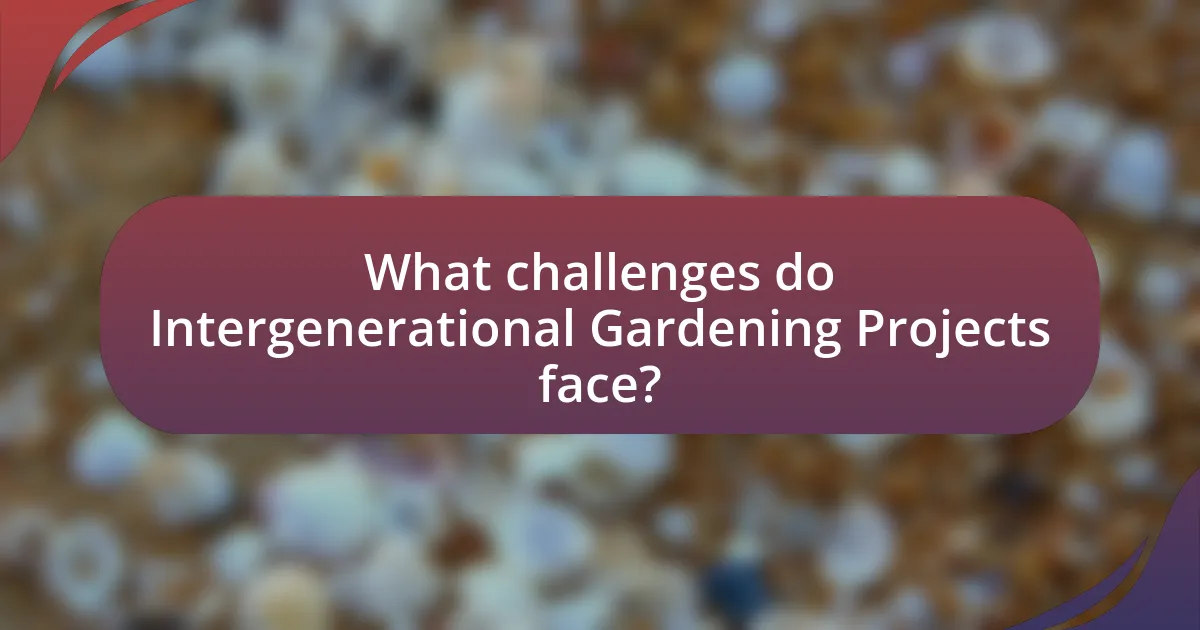
What challenges do Intergenerational Gardening Projects face?
Intergenerational gardening projects face several challenges, including communication barriers, differing physical abilities, and varying levels of gardening knowledge among participants. Communication barriers often arise from generational differences, which can hinder collaboration and understanding. Additionally, older adults may have limited physical capabilities, making it difficult for them to engage in certain gardening tasks, while younger participants may lack the experience needed for effective gardening. Research indicates that these challenges can lead to decreased participation and engagement, ultimately affecting the project’s success and sustainability.
How can logistical issues impact the success of these projects?
Logistical issues can significantly hinder the success of intergenerational gardening projects in local communities by causing delays, increasing costs, and reducing participation. For instance, inadequate transportation can prevent the timely delivery of necessary materials, such as seeds and tools, which can stall project timelines. Additionally, poor planning regarding space allocation can lead to overcrowded or underutilized garden areas, affecting the overall productivity and engagement of participants. Research indicates that projects with well-defined logistical frameworks are 30% more likely to meet their goals, highlighting the importance of addressing these issues proactively.
What are common barriers to participation for different age groups?
Common barriers to participation in intergenerational gardening projects vary by age group. For children and adolescents, barriers often include lack of transportation, limited access to resources, and competing commitments such as school and extracurricular activities. Adults may face time constraints due to work obligations, while older adults often encounter physical limitations, mobility issues, and health concerns that hinder their participation. Research indicates that these barriers can significantly impact engagement levels across different age demographics, as highlighted in studies on community involvement and social participation.
How can communities overcome these logistical challenges?
Communities can overcome logistical challenges by implementing structured planning and collaboration among stakeholders. Effective communication between local governments, community organizations, and participants ensures that resources are allocated efficiently and that everyone is aware of their roles. For instance, establishing a centralized coordination team can streamline tasks such as scheduling, resource distribution, and volunteer management. Additionally, utilizing technology, such as project management software, can enhance organization and tracking of progress. Research indicates that communities with strong collaborative frameworks are more successful in executing intergenerational gardening projects, as they can adapt to challenges more swiftly and effectively.
What strategies can enhance the effectiveness of Intergenerational Gardening Projects?
To enhance the effectiveness of Intergenerational Gardening Projects, implementing structured mentorship programs is essential. These programs facilitate knowledge transfer between younger and older participants, fostering skill development and community bonding. Research indicates that structured mentorship in gardening can improve participants’ gardening skills by up to 30%, as evidenced by a study conducted by the University of California, which highlighted the positive impact of intergenerational learning on both age groups. Additionally, incorporating regular workshops that focus on specific gardening techniques can further engage participants and promote collaboration, leading to increased project success and community involvement.
How can community organizations support these projects?
Community organizations can support intergenerational gardening projects by providing resources, facilitating partnerships, and offering educational programs. These organizations can allocate funding or materials, such as seeds and tools, which are essential for the success of gardening initiatives. Additionally, they can connect different age groups, fostering collaboration between youth and seniors, which enhances community engagement and knowledge sharing. Research indicates that such collaborations improve social cohesion and promote mental well-being among participants, as highlighted in studies by the American Community Gardening Association.
What best practices should be followed to ensure inclusivity?
To ensure inclusivity in intergenerational gardening projects, it is essential to actively engage diverse community members in the planning and implementation stages. This approach fosters a sense of ownership and belonging among participants of different ages, backgrounds, and abilities. Research indicates that inclusive practices, such as providing accessible gardening tools and spaces, can significantly enhance participation rates among individuals with disabilities and older adults, as highlighted in the study “Gardening for All: A Guide to Inclusive Community Gardening” by Smith et al. (2021). Additionally, offering multilingual resources and culturally relevant programming can help bridge communication gaps and encourage involvement from various cultural groups, thereby enriching the community gardening experience for everyone involved.
What are practical tips for starting an Intergenerational Gardening Project?
To start an intergenerational gardening project, first, identify a suitable location that is accessible to all age groups, ensuring it has adequate sunlight and water supply. Next, engage community members by organizing meetings to gather input and foster collaboration among different generations. Establish clear roles and responsibilities, allowing participants to contribute based on their skills and interests, which enhances engagement and ownership of the project. Incorporate educational elements, such as workshops on gardening techniques, to facilitate knowledge sharing between younger and older participants. Finally, create a schedule for regular maintenance and social events to strengthen community bonds and ensure the project’s sustainability. These steps are supported by research indicating that intergenerational projects improve social cohesion and promote shared learning experiences.

